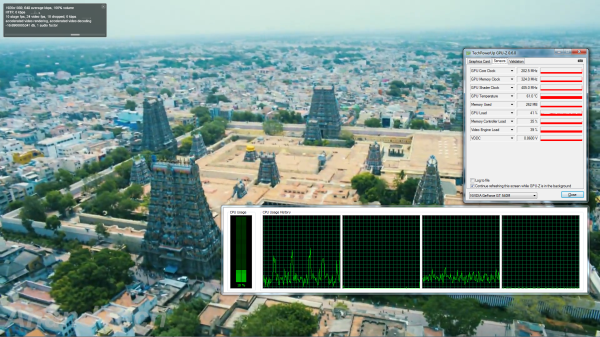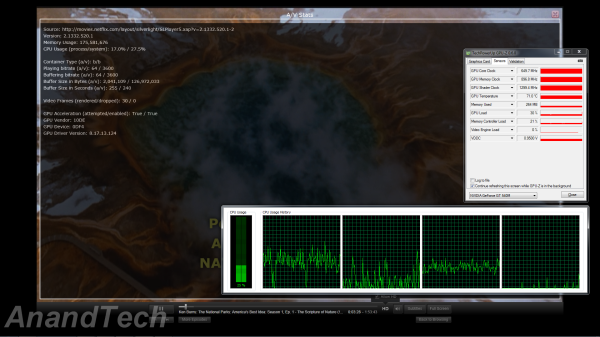ASRock's High-End Vision 3D 252B HTPC Review
by Ganesh T S on May 7, 2012 6:15 AM EST- Posted in
- Home Theater
- Sandy Bridge
- HTPC
- GT 540M
- NVIDIA
The ASRock Vision 3D 252B is covered quite nicely with respect to networking hardware. With support for both Gigabit Ethernet and 802.11n, it really doesn't matter if you keep the unit beyond cable reach from the router. All our network streaming tests were carried out with a 300 Mbps 802.11n network (currently provided in my lab location by a RT-N16 802.11n gigabit router from Asus). We were easily able to stream HD clips of more than 50 Mbps. HD YouTube videos and HD Netflix streaming had no issues.
While on the topic of network streaming, let us take a brief look at how the system performs while accessing online video services. We used Flash 11.2 in Firefox with NVIDIA's v301.24 drivers for testing. The first set of screenshots below show the CPU usage while playing back a 1080p YouTube video with hardware acceleration enabled. This is the same clip used in all the other SFF HTPC reviews.
1080p YouTube HD Streaming with Hardware Acceleration (Flash in Firefox)
Netflix streaming, on the other hand, uses Microsoft's Silverlight technology. Unlike Flash, hardware acceleration for the video decode process is not controlled by the user. It is upto the server side code to attempt GPU acceleration. Thankfully, Netflix does try to take advantage of the GPU's capabilities. This is evident from the A/V stats recorded while streaming a Netflix HD video at the maximum possible bitrate of 3.8 Mbps. While the video is definitely not 1080p, we observe that the CPU utilization of around 18% is lower than the CPU usage for a 1080p YouTube video.
Netflix HD Streaming with Hardware Acceleration
Users of media streamers streaming online videos often have to put up with messages of the sort 'This content is not available on TV connected devices' or need to queue up the videos on a PC before accessing them through their media streamer box. HTPC users don't need to worry about any such limitations. On a side note, it is disappointing to see Netflix restrict its 1080p / DD+ 5.1 offerings to the PS3 and Roku 2. It is the PC platform which launched the streaming business for Netflix. It would be good if they do not relegate HTPC users to being second string consumers as their popularity grows.












60 Comments
View All Comments
jabber - Monday, May 7, 2012 - link
I bought about a dozen of the first generation Atom boxes and they are all still trucking and the customers still love them.I still want one for myself.
TerdFerguson - Monday, May 7, 2012 - link
For what they were meant for, the little ION machines were flipping fantastic. With a package price of below $200 for everything but the OS, it's a value proposition that hasn't been matched by anything since.duploxxx - Monday, May 7, 2012 - link
yes there are but not all OEM have the guts to do it right and just stuff garbage onto consumers. If they love it means they have never used anything else...http://www.anandtech.com/show/4442/zotac-zbox-braz...
BPB - Monday, May 7, 2012 - link
Am I the only guy who goes to the bottom of the specs sheet first and looks fir price? This thing is way too much for an HTPC.duploxxx - Monday, May 7, 2012 - link
what would you expect if you see following specs...Intel Sandy Bridge Core i5-2520M
(2 x 3.00 GHz (3.20 GHz Turbo), 32nm, 3MB L2, 35W)
Graphics NVIDIA GT 540M (1 GB VRAM)
1 reason why you would need these 2 parts into a HTPC, can be replaced by 1 APU which cost less and consumes less in total, end of story.
BPB - Monday, May 7, 2012 - link
I am not saying it isn't worth it. I am saying I see HTPC in the review title, look at the price, and think it's not worth reading the article. Simply can't see spending that on an HTPC, that's all. It is not a knock on the product. I'd be very happy owning this.cknobman - Monday, May 7, 2012 - link
Agreed.Over $1000 for a HTPC and then with these specs to boot?
Im not saying the specs are bad but they are certainly not worth of over $1000.
mbzastava - Monday, May 7, 2012 - link
I recall reading a nice comment from the Intel NUC article which points out how this new form factor is just repackaged laptop parts whith a nice new profit margin. I couldn't agree with him more.The question you should be asking is: Why does this unit cost around $1000 when you could get a similarly specced laptop for almost $300 less?
ganeshts - Monday, May 7, 2012 - link
Economy of scale - How many such HTPCs are going to be purchased vs. how many laptops the vendor would sell.blackbrrd - Monday, May 7, 2012 - link
I just use a laptop as a HTPC. You can get a decent laptop for waaay less than this costs, and you can use it as a laptop if you need one.